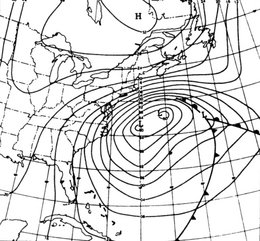 Surface weather analysis on March 7, 1962 (Ash Wednesday) | |
| Type | Nor'easter |
|---|---|
| Formed | March 4, 1962 |
| Dissipated | March 9, 1962 |
| Highest gust | 84 mph (135 km/h) on Block Island, Rhode Island |
| Lowest pressure | 979 mb (28.91 inHg) |
| Maximum snowfall or ice accretion | 23.6 inches 599 mm (59.9 cm) |
| Fatalities | 40 |
| Damage | $200 million (1962 USD) |
| Areas affected | East Coast of the United States |
The Ash Wednesday Storm of 1962 occurred on March 5–9, 1962 along the mid-Atlantic coast of the United States. Also known as the Great March Storm of 1962, it was considered by the U.S. Geological Survey to be one of the most destructive storms ever to affect the mid-Atlantic states. Classified as a level 5 or Extreme Nor'easter by the Dolan-Davis scale for classification of Atlantic Nor'easters[1] it was one of the ten worst storms in the United States in the 20th century. It lingered through five high tides over a three-day period, killing 40 people, injuring over 1,000, and causing hundreds of millions in property damage in six states. The storm also deposited significant snowfall over the Southeast, with a regional snowfall index of 12.663.[2]
- ^ Schwartz, Maurice (Nov 8, 2006). Encyclopedia of Coastal Science. Springer Science & Business Media. p. 680. ISBN 978-1-4020-1903-6.
- ^ "Regional Snowfall Index (RSI)". NOAA. Retrieved January 11, 2016.